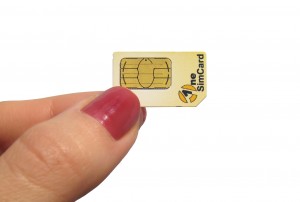 Get an unlocked phone with a SIM card (GSM chip). Prior to your departure, find a carrier in your destination land that sells “pay as you go” or “top up” or “non-subscriber service” or “PrePaid” GSM chips or SIM cards. Pay ridiculously low prices for these (for example, $4), buy a ton of cheap minutes, and call to the USA 10 cents/minute. This contrasts radically with USA-based-cell-carrier plans, which typically make you pay at least three times that much. If you thought you’d just use your regular cell phone, think again. At least call your customer service rep before you leave your homeland so you know exactly what you’re going to spend. (It could be HUNDREDS of dollars in a week’s worth of calls.) Buying a local sim card will almost always be the best route. What’s more, it gives you a local number so local contacts can easily call you about schedule changes. If you want fast, inexpensive choices, just call an all-stop-shop like
Get an unlocked phone with a SIM card (GSM chip). Prior to your departure, find a carrier in your destination land that sells “pay as you go” or “top up” or “non-subscriber service” or “PrePaid” GSM chips or SIM cards. Pay ridiculously low prices for these (for example, $4), buy a ton of cheap minutes, and call to the USA 10 cents/minute. This contrasts radically with USA-based-cell-carrier plans, which typically make you pay at least three times that much. If you thought you’d just use your regular cell phone, think again. At least call your customer service rep before you leave your homeland so you know exactly what you’re going to spend. (It could be HUNDREDS of dollars in a week’s worth of calls.) Buying a local sim card will almost always be the best route. What’s more, it gives you a local number so local contacts can easily call you about schedule changes. If you want fast, inexpensive choices, just call an all-stop-shop like
Their informed customer service folks will always steer you right. If you want to keep the Telestial folks honest on prices, comparison shop first at…










A couple of quick comments…
1. I finally just switched to T-Mobile, which offers wi-fi calling and unlimited free data overseas (I am based in the U.S.). I don’t think you’re getting the best speed available, but free is good, and the wi-fi based calling makes actual phone calls, well, free.
2. In some countries, local SIM cards may come with free Facebook access. I used one in Thailand this past spring, and all FB data was free, including photos & possibly videos. Nice bonus if you use FB to keep in touch with folks.
3. Those wanting the best of both worlds may want to consider a dual-SIM phone option that allows you to use your usual (home country) phone number PLUS cheaper services that you can get with a local SIM. It may be worth looking for a cheap phone with this feature that you use just when traveling.
4. Apps like WhatsApp and Viber make communications more affordable than traditional voice calls while overseas.